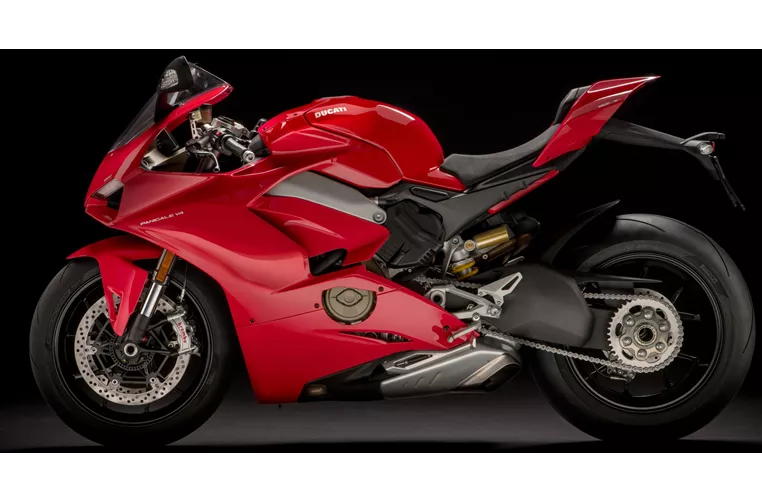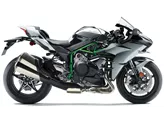Ducati Panigale V4 2018 vs. BMW S 1000 RR 2015

Ducati Panigale V4 2018

BMW S 1000 RR 2015
Overview - Ducati Panigale V4 2018 vs BMW S 1000 RR 2015
The Ducati Panigale V4 2018 and the BMW S 1000 RR 2015 are both high-performance supersport motorcycles, but they have some notable differences in their technical specifications and strengths.
In terms of engine and drive train, the Ducati Panigale V4 2018 is equipped with a V4 engine, while the BMW S 1000 RR 2015 has an in-line four-cylinder engine. The Panigale V4 has a larger bore and stroke, resulting in a higher displacement of 1103cc compared to the S 1000 RR's 999cc. This larger displacement contributes to the Panigale V4's higher engine power of 214 HP, compared to the S 1000 RR's 199 HP. The Panigale V4 also has a higher torque of 124 Nm, compared to the S 1000 RR's 113 Nm. Both motorcycles have a compression ratio of around 13-14.
In terms of suspension, the Panigale V4 features an upside-down telescopic fork at the front and a single swing arm at the rear. The S 1000 RR, on the other hand, has a telescopic fork at the front and a swing arm at the rear. Both motorcycles have an aluminum frame, but the Panigale V4's frame is of the monocoque type, while the S 1000 RR's frame is a twin tube design.

Ducati Panigale V4 2018
Both motorcycles have double disk brakes at the front, with radial technology and monoblock calipers for the Panigale V4 and radial technology for the S 1000 RR. The Panigale V4 has a front tire width of 120mm and a rear tire width of 200mm, compared to the S 1000 RR's front tire width of 120mm and rear tire width of 190mm. Both motorcycles have a 17-inch diameter for their front and rear tires.
In terms of dimensions and weights, the Panigale V4 has a longer wheelbase of 1469mm, compared to the S 1000 RR's 1425mm. The Panigale V4 also has a higher seat height of 830mm, compared to the S 1000 RR's 815mm. The Panigale V4 has a kerb weight of 198kg with ABS, while the S 1000 RR has a slightly higher kerb weight of 204kg with ABS. The S 1000 RR also has a larger fuel tank capacity of 17.5 liters, compared to the Panigale V4's 16 liters.

BMW S 1000 RR 2015
Now, let's discuss the strengths and weaknesses of each motorcycle. The Panigale V4's strengths include its powerful engine with charisma and great manners, a pleasant upper body position compared to other supersport bikes, a sufficiently dimensioned chassis for country roads, a powerful but not intrusive sound, and good wind protection. On the other hand, the Panigale V4's weaknesses include a seat that gets warm, especially in city traffic, and an engine/clutch that may feel a little rough in tight hairpin bends.
The S 1000 RR's strengths include a superb shift assistant, an incredibly powerful and rev-happy engine, a great range of accessories, and the availability of a race-ready data logging tool and calibration tool. However, the S 1000 RR's chassis may quickly reach its limit in the hands of professionals, which can be considered a weakness.
In summary, the Ducati Panigale V4 2018 and the BMW S 1000 RR 2015 are both powerful and capable supersport motorcycles, but they have some differences in their technical specifications and strengths. The Panigale V4 offers a powerful engine and a comfortable riding position, while the S 1000 RR excels in its shift assistant and engine performance. Both motorcycles have their own unique strengths and weaknesses, catering to different preferences and riding styles.
Technical Specifications Ducati Panigale V4 2018 compared to BMW S 1000 RR 2015
Pros and Cons in comparison
Pros and Cons in comparison
Ducati Panigale V4 2018

The Panigale has become much more accessible in the 2018 V4 version than before. The engine, in combination with the electronics package, is still not as flawless and sterile as an inline four, but in practice it is a real blessing for Ducatisti - and a positive surprise for riders of other brands. The Panigale V4 also surprised with tolerable riding comfort on the country road and a pleasant level of stability. Progress here was clearly in the right direction. The new V4 is stronger and faster but also easier and more pleasant to ride.
BMW S 1000 RR 2015

The BMW can still score points with hard facts in 2015. If you like top performance, you have to buy the BMW. It turns out incredibly powerful at the top and drives away the rest of the field from 200. Big and heavy riders will be able to benefit from this even more. BMW didn't make it easy for themselves with this bike and put together a very universal motorbike. If you were to do a comparison test with 50 different riders (from rookie to pro), the BMW would have the best average of all 1000cc bikes. The electronic chassis, but also the riding aids, make the pros fast and the beginners safe on the road. A top recommendation for a very broad target group. Very fast hobby riders will not be 100% satisfied with the standard suspension. If you don't want to modify the chassis, you should rather go for an R1M, a Panigale S or an RSV RF. If you want to convert anyway, the S 1000 RR is the strongest and most universal base. Surprisingly, the powerful machine also rides very well on country roads. All in all, it looks like a compromise, but it never feels like one in practice.
Price Comparison Avarage Market Price Ducati Panigale V4 vs BMW S 1000 RR
There are a few key differences between a Ducati Panigale V4 2018 and a BMW S 1000 RR 2015. In terms of price, the actual average price of a Ducati Panigale V4 2018 is about 31% higher. A Ducati Panigale V4 2018 experiences a loss of 1,130 USD in one year and 2,480 USD in two years of ownership. This is offset by a loss of 1,560 USD and 840 USD for a BMW S 1000 RR 2015. Compared to BMW S 1000 RR 2015 there are less Ducati Panigale V4 2018 bikes available on the 1000PS.de Marketplace, specifically 5 compared to 8. It takes less time to sell a BMW S 1000 RR with 77 days compared to 91 days for the Ducati Panigale V4. Since model year 2018 1000PS.de editors have written 18 reviews for the Ducati Panigale V4 and 135 reviews for the BMW S 1000 RR since model year 2010. The first review for the Ducati Panigale V4 was published on 11/5/2017 and now has more than 131,500 views. This compares to more than 4,000 views for the first review on BMW S 1000 RR published on 4/16/2008.
























